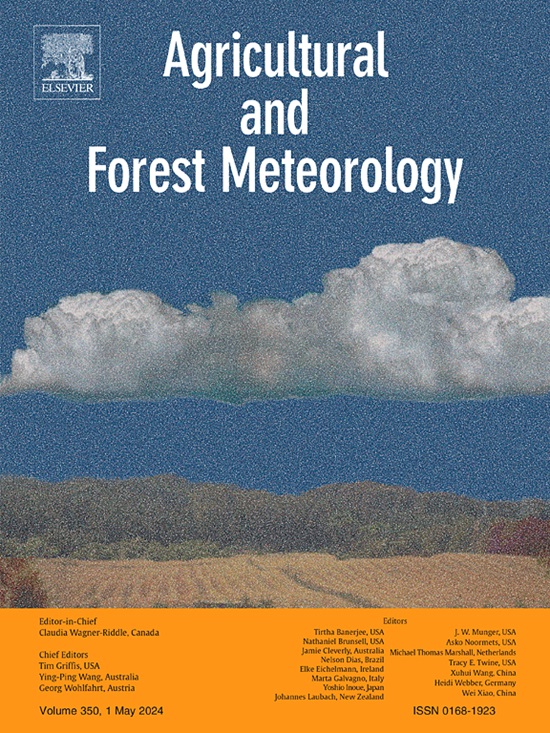The influence of 3D canopy structure on modelled photosynthesis
IF 5.6
1区 农林科学
Q1 AGRONOMY
引用次数: 0
Abstract
Vegetation is one of the largest terrestrial sinks of atmospheric carbon dioxide, driven by the balance between photosynthesis and respiration. Understanding the processes behind this net flux is critical, as it influences the global atmospheric carbon dioxide concentration and hence climate change. A key factor determining the carbon flux into the land surface is the absorption of light by vegetation, used to drive photosynthesis. However, climate models commonly represent vegetation canopies as homogenous slabs of randomly positioned leaves. By contrast, real forests generally exhibit large amounts of 3-dimensional heterogeneity.
We examine the impact of including measured 3D vegetation canopy structure on modelled gross primary productivity (GPP) by looking at how leaf area is distributed. We introduce a methodology to calculate GPP using output from the explicit Discrete Anisotropic Radiative Transfer (DART) model, following the approach commonly used in land surface schemes. The sensitivity of modelled GPP to canopy structure assumptions in Earth system models is explored, using 3D structural information derived from six forest plots using Terrestrial Lidar Scanning (TLS) data. Here, we use the spatial resolution as a proxy for the canopy structure, with the very coarsest simulations containing no spatial variability in leaf location, with variability introduced as the resolution of the simulations becomes finer. In almost all cases, the simulated GPP is reduced, and with the finest resolution this is up to 25 %. This contrasts with recent studies showing the opposite effect. In the few cases where the GPP increased, this was only marginal (< 2.5 %). These results suggest that not accounting for the impact of 3-dimensional canopy structure could lead to significant biases in land surface models, particularly in forest's contribution to the global carbon budget. We suggest that vegetation structure is considered, explicitly or through a correction factor, alongside a comparison to existing clumping approaches.
三维冠层结构对模拟光合作用的影响
植被是最大的陆地大气二氧化碳汇之一,由光合作用和呼吸作用之间的平衡驱动。了解这一净通量背后的过程至关重要,因为它影响全球大气二氧化碳浓度,从而影响气候变化。决定进入陆地表面的碳通量的一个关键因素是植被对光的吸收,用于推动光合作用。然而,气候模型通常将植被冠层表示为随机定位的叶片的均匀板。相比之下,真正的森林通常表现出大量的三维异质性。我们通过观察叶面积的分布,研究了包括测量的三维植被冠层结构对模拟的总初级生产力(GPP)的影响。本文介绍了一种利用显式离散各向异性辐射传输(DART)模型的输出来计算GPP的方法,该方法遵循地表方案中常用的方法。利用基于地面激光雷达扫描(TLS)数据的六个森林样地的三维结构信息,探讨了模拟GPP对地球系统模型中冠层结构假设的敏感性。在这里,我们使用空间分辨率作为冠层结构的代表,非常粗糙的模拟不包含叶片位置的空间变异性,随着模拟分辨率变得更精细,变异性被引入。在几乎所有的情况下,模拟的GPP都降低了,在最好的分辨率下,这可以达到25%。这与最近的研究结果相反。在GPP增加的少数情况下,这只是边际效应(<;2.5%)。这些结果表明,不考虑三维冠层结构的影响可能会导致陆地表面模型的显著偏差,特别是在森林对全球碳收支的贡献方面。我们建议考虑植被结构,明确地或通过一个校正因子,并与现有的聚类方法进行比较。
本文章由计算机程序翻译,如有差异,请以英文原文为准。
求助全文
约1分钟内获得全文
求助全文
来源期刊
CiteScore
10.30
自引率
9.70%
发文量
415
审稿时长
69 days
期刊介绍:
Agricultural and Forest Meteorology is an international journal for the publication of original articles and reviews on the inter-relationship between meteorology, agriculture, forestry, and natural ecosystems. Emphasis is on basic and applied scientific research relevant to practical problems in the field of plant and soil sciences, ecology and biogeochemistry as affected by weather as well as climate variability and change. Theoretical models should be tested against experimental data. Articles must appeal to an international audience. Special issues devoted to single topics are also published.
Typical topics include canopy micrometeorology (e.g. canopy radiation transfer, turbulence near the ground, evapotranspiration, energy balance, fluxes of trace gases), micrometeorological instrumentation (e.g., sensors for trace gases, flux measurement instruments, radiation measurement techniques), aerobiology (e.g. the dispersion of pollen, spores, insects and pesticides), biometeorology (e.g. the effect of weather and climate on plant distribution, crop yield, water-use efficiency, and plant phenology), forest-fire/weather interactions, and feedbacks from vegetation to weather and the climate system.

 求助内容:
求助内容: 应助结果提醒方式:
应助结果提醒方式:


